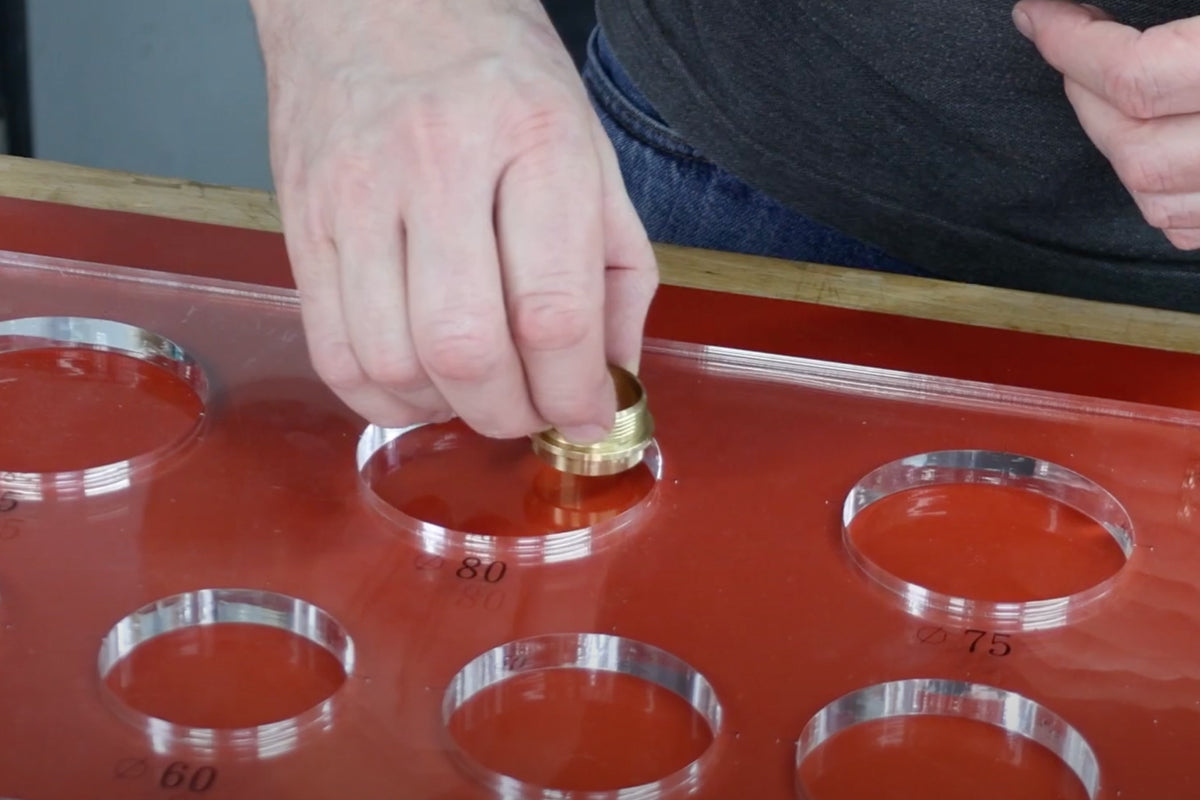In the second of three tests of tools available from Wood Workers Workshop, Jonathan Salisbury looks at this handy routing aid.
The Woodworker & Good Woodworking
Router templates are easy to make from any flat material, and many woodworkers use MDF. The problem with MDF, however, is that it starts to wear quite quickly, with diminishing accuracy the end result. Add a bit of damp, and you have a template that’s far from ideal. Plywood is preferable, but acrylic is better – especially if you have a laser cutter. But if you don’t, there’s the AUKTools Circular Router Inlay Template. Laser cut from clear 10mm thick acrylic, the corners have 30, 40, 50 and 60mm radii and the 12 holes start at 30mm diameter and increase in 5mm steps, all the way up to 85mm.
Dimensionally speaking
To cut a shallow hole for storage, or an inlay, you’ll need to use bushes. The marked size is true – the holes aren’t oversized to compensate for a guide – so to get the required diameter hole, you need to calculate the difference between the outside of the bush and cutting edge. I had a 30mm guide bush and 10mm straight cutter already installed in my router, so the 65mm diameter template created a 45mm diameter hole. Similarly, using the guide bush will increase the corner radius by 10mm, so a 20mm radius will end up as 30mm. For outside edges and through-holes, a bearing-guided cutter could be used instead – as long as the bearing, and not the cutter, is in line with the template before you start! Combining different cutters and guides will increase the range of radii and holes that can be created.
In use
The template is very straightforward to use: simply clamp or use double-sided tape to hold it in position, place your router, plunge, then move. The large, smooth surface is ideal for the router base to ride over; unused holes don’t cause it to rock, because they’re small and widely spaced.
Acrylic is reasonably hard, but don’t expect it to remain in pristine glass-clear condition. The fine crosshairs on the top make it easier to align the required hole with your centre marks, although unless looking from directly above the hole’s centre the template will, more often than not, be in the wrong place. The parallax error caused by a transparent 10mm thick sheet of acrylic is quite considerable, but I solved this problem by using the template upside down. You couldn’t do that with MDF! I wonder if I could get commission for suggesting that the crosshairs ought to be on the underside.
Conclusion
This template is far superior to my home-made MDF and plywood efforts, but then it ought to be! While the price seems quite high, 10mm acrylic is pretty expensive, as is a laser cutter… Even so, not everyone could justify the cost for a one-off project, but if the template was going to be used frequently, it would prove to be a very good investment.
Specification
- Cut perfect circles with your router
- Material: 10mm thick acrylic
- 12 full circle diameters: 30mm; 35mm; 40mm; 45mm; 50mm; 55mm; 60mm; 65mm; 70mm; 75mm; 80mm; 85mm
- Four quarter circle radii: 20mm; 30mm; 40mm; 50mm
The Verdict
- Pros: Very accurate; convenient method of keeping several guide holes together; longer lasting and easier to line up than home-made MDF or plywood versions; clearly marked radii and diameters, with crosshairs for alignment.
- Cons: Requires appropriate guide bush and cutter combinations to achieve the desired hole size; holes aren’t oversized to allow for guide bushes; shallow 85mm holes would be difficult to achieve; material thickness can cause parallax-related inaccuracies when lining up, unless used upside down.
- Performance Rating: 4.5 out of 5
- Value Rating: 5 out of 5

